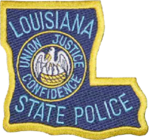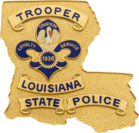Louisiana State Police
| Louisiana State Police | |
|---|---|
| Abbreviation | LSP |

Patch of the Louisiana State Police
|
|

Badge of the Louisiana State Police
|
|

Flag of the State of Louisiana
|
|
| Motto | "Courtesy, Loyalty, Service!" |
| Agency overview | |
| Formed | 1922 |
| Preceding agency | Louisiana Highway Commission |
| Employees | 1,548 (as of 2004) |
| Legal personality | Governmental: Government agency |
| Jurisdictional structure | |
| Operations jurisdiction* | State of Louisiana, US |
 |
|
| LSP Troop Map | |
| Size | 51,885 square miles (134,380 km2) |
| Population | 4,468,976 |
| Legal jurisdiction | Louisiana |
| General nature | |
| Operational structure | |
| Headquarters | Baton Rouge, Louisiana |
| Troopers | 1,063 (as of 2004) 1,215 (as of 2008) |
| Civilians | 485 (as of 2004) |
| Agency executive | Colonel Mike Edmonson, Superintendent |
| Parent agency | Louisiana Department of Public Safety & Corrections |
| Facilities | |
| Troops | 10 Troops |
| Website | |
| http://www.lsp.org | |
| Footnotes | |
| * Divisional agency: Division of the country, over which the agency has usual operational jurisdiction. | |
The Louisiana State Police is the state police department of Louisiana, which has jurisdiction anywhere in the state, headquartered in Baton Rouge. It was created to protect the lives, property and constitutional rights of people in Louisiana. It falls under the authority of the Louisiana Department of Public Safety & Corrections. It is officially known in that organization as the Office of State Police. The badge worn by its troopers is very distinctive in that it is shaped like the state of Louisiana. The Louisiana State Police is a premier law enforcement agency in Louisiana and was accredited by the Commission on Accreditation for Law Enforcement Agencies (CALEA) from 2003 to 2008. The agency voluntarily ceased its association with CALEA in 2008.
The organization began in 1922 as the Louisiana Highway Commission with 16 Highway Inspectors covering approximately 2,700 miles (4,300 km) of roadway. These inspectors patrolled exclusively by motorcycles. These motorcycles were personally owned by the individual patrolmen, and maintained by an allowance from the state. Of the 16 men on the force, one was a captain. This captain served as superintendent of the force. The highway commission was divided into ten districts. The Baton Rouge District had two patrol officers, while the New Orleans District had three patrolmen. The other eight districts had one patrol officer each. The other two officers patrolled statewide on the main highways of the state. In 1928 the agency was known as the Law Enforcement Division of the Highway Commission, and employed 70 uniformed officers. The Bureau of Criminal Investigation was also formed about that time. In 1932, the organization's name was changed to the State Highway Patrol, and it was given the authority to carry firearms. The agency was used by Governor Huey Long as his personal bodyguards, who escorted him all over the state. In 1936, the two divisions of law enforcement were combined, by an act of the Louisiana Legislature, to form the Louisiana Department of State Police. The department's force of patrolmen numbered over 40 at that time, and the primary patrol vehicle was the motorcycle. In 1939, the State Police was divided into eight "troops". Troopers in cars and motorcycles were patrolling nearly 2 million miles per year throughout the state. The agency's fleet of patrol motorcycles eventually grew to 64 motorcycles. In 1942 the Louisiana Legislature abolished the Department of State Police and made it a division of the newly created Department of Public Safety. The state police accepted new responsibilities in 1946, when the state's Drivers License Law was enacted requiring every driver to hold a license for operating a motor vehicle. Prior to this time, only the operators of commercial vehicles, trucks, and buses were required to be licensed in Louisiana. In 1948, the number of motorcycles operated by the agency had fallen to 36 motorcycles. The department was relying more heavily on automobiles for patrol purposes, and eventually patrol motorcycles were only found in New Orleans and other major cities. Motorcycle patrol units were used throughout the 1950s, with Governor Earl Kemp Long also using them as bodyguards. In the 1960s, the department was utilizing motorcycles, automobiles, airplanes, and helicopters for enforcement purposes. The department had exclusively used Harley-Davidson motorcycles until the 1980s when it switched to Kawasaki motorcycles. A short time after this switch, the motorcycle patrol program was disbanded. In 1997, patrol motorcycles were brought back on the force. The agency continued to make advancements with the current number of troopers employed by the department listed as 1,022.
...
Wikipedia
